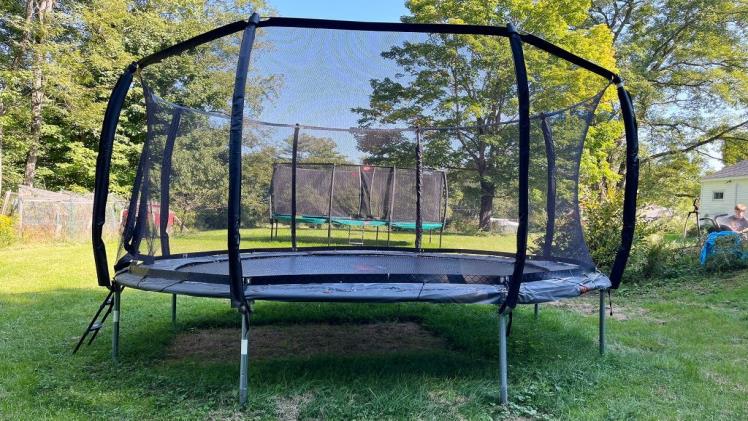Trampolines aren’t just fun—they’re a fantastic way for kids and adults alike to stay active right at home. But when it comes to choosing the right trampoline, homeowners often face a common dilemma: Indoor trampoline or outdoor trampoline? Each option comes with unique benefits, limitations, and safety considerations. In this guide, we’ll break down the pros and cons of both types to help you decide which trampoline is the best fit for your home.
Contents
- 1 Benefits of Indoor Trampolines
- 2 1. Perfect for Small Spaces
- 3 2. All-Weather Usability
- 4 3. Safer Supervision
- 5 4. Fitness at Home
- 6 Benefits of Outdoor Trampolines
- 7 1. Larger Size for Multiple Users
- 8 2. Enjoy the Outdoors
- 9 3. Supports Advanced Tricks
- 10 4. Adds Backyard Value
- 11 Indoor vs. Outdoor Trampoline: Key Differences
- 12 Who Should Choose Indoor vs. Outdoor Trampolines
- 13 Safety Tips for Both Types
- 14 Conclusion
Benefits of Indoor Trampolines
Indoor trampoline is perfect for homes with limited space or families who want a safe, all-weather exercise option. Here are some key advantages:
1. Perfect for Small Spaces
Indoor trampolines are typically smaller, making them ideal for apartments, condos, or homes without a large backyard. They can fit in playrooms, basements, or even living areas.
2. All-Weather Usability
Rain or shine, an indoor trampoline is always ready. You won’t have to worry about muddy lawns, strong winds, or extreme temperatures disrupting playtime.
3. Safer Supervision
Indoor trampolines are usually easier to monitor, especially for young children. Many models come with padded edges and safety nets for added protection.
4. Fitness at Home
From cardio workouts to balance exercises, indoor trampolines are a convenient way for adults and kids to stay active without leaving home.
Benefits of Outdoor Trampolines
Outdoor trampoline, often larger and more durable, offer a different set of advantages, particularly for families with ample backyard space.
1. Larger Size for Multiple Users
Outdoor trampolines often accommodate more than one jumper at a time, making them great for siblings or neighborhood friends.
2. Enjoy the Outdoors
Jumping on an outdoor trampoline gives kids and adults the added benefits of fresh air, sunlight, and a connection to nature.
3. Supports Advanced Tricks
The larger jumping surface allows for more advanced maneuvers and flips, making it ideal for fitness enthusiasts or active children.
4. Adds Backyard Value
A well-placed outdoor trampoline can enhance your backyard’s play area, making it a fun feature for family gatherings and social activities.
Indoor vs. Outdoor Trampoline: Key Differences
| Feature | Indoor Trampoline | Outdoor Trampoline |
| Space Needed | Small, compact | Requires large backyard |
| Weather Impact | Can be used year-round | Exposure to sun, rain, wind |
| Safety | Easier supervision | Requires more safety measures |
| Cost | Generally lower | Often higher due to size and durability |
| Maintenance | Minimal cleaning | Needs weatherproofing and inspection |
Who Should Choose Indoor vs. Outdoor Trampolines
- Indoor trampoline: Ideal for families with young kids, apartment dwellers, or those seeking year-round indoor exercise.
- Outdoor trampoline: Perfect for homeowners with large backyards, older kids, or fitness enthusiasts looking for more space and variety.
Safety Tips for Both Types
Regardless of the trampoline type, safety should always come first:
- Always supervise children while jumping.
- Use safety nets, padding, and appropriate footwear.
- Check weight limits and adhere to manufacturer guidelines.
- Regularly inspect the trampoline for wear and tear or damage.
Conclusion
Choosing between an indoor trampoline and an outdoor trampoline ultimately comes down to your space, budget, and lifestyle. Indoor trampolines are compact, safe, and usable year-round, making them perfect for small spaces and younger children. Outdoor trampolines offer more space, outdoor fun, and support for multiple users or advanced tricks, making them ideal for larger homes and backyards.
Consider your home setup, the age of your children, and your fitness goals to make the best choice. With the right trampoline, your home can become a hub of fun, activity, and healthy exercise for the whole family
